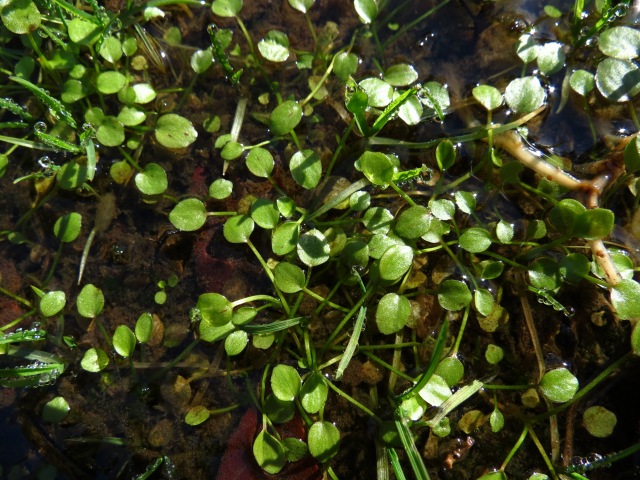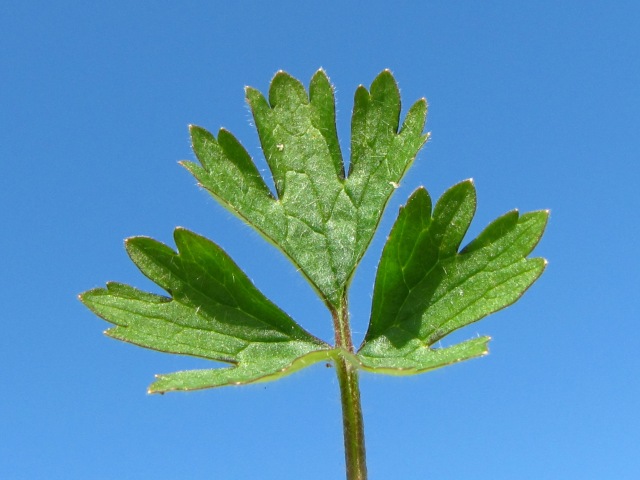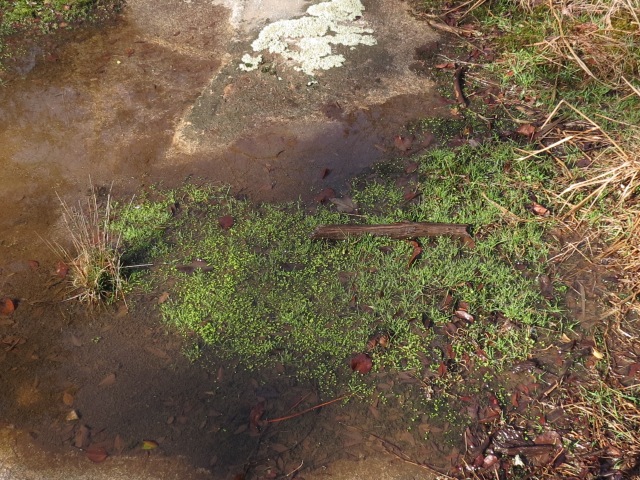Low Spearwort (Ranunculus pusillus) is a common inhabitant of wet and marshy lowlands and ditches in North Carolina, especially in the Central Piedmont and Coastal Plain. It is a native plant, and a member of the large Buttercup family, the Ranunculaceae. Its life cycle and adaptability have allowed it to colonize wet areas and depression pools on the granitic flatrocks of the Mitchell Mill State Natural Area.
The plants themselves are quite small and the flowers are inconspicuous, having only 1 to 3 small petals. The basal leaves are round to oval and the stem leaves point upright and are spear-shaped, giving rise to the name Spearwort. Below is a colony of Low Spearwort in full bloom in April of last year.
Below is the same colony as it appears now in January 2015. Only round-leaved basal rosettes are present at this time.
Ranunculus pusillus is separated from other members of the Buttercup family by having unlobed leaves at all stages of development. A closer view of the basal leaves follows.
A leaf of Ranunculus bulbosus, the Bulbous Buttercup, is pictured below, demonstrating the more typical appearance of a buttercup leaf with lobes.
Low Spearwort can even colonize depression pools out on the granite flatrock surface. Here, the lower leaves of two Spearworts are pointing down to a small, developing Elf Orpine (Diamorpha smallii). Growing up through the Spearwort on the right is an early winter form of Appalachian Stitchwort (Minuartia glabra). Another can be seen at the upper left corner of the photo.
Following is a view of a Low Spearwort colony at a greater distance, showing its location on the edge of a flatrock. As summer approaches, and the Spearwort colony begins to wane, Portulaca smallii (Small’s Purslane) will become noticeable in the thin mud at the margins around the colony and also within the colony.
The Mitchell Mill State Natural Area offers the opportunity to observe the interactions between plants endemic to the flatrocks, and regional plants like Low Spearwort, that are able to exploit the wet environment and co-exist on the granite flatrocks.
Herb Amyx







Herb, Your lovely photographs make these small, inconspicuous plants so dramatic! I really enjoy your “showcase” of our unheralded yet exciting botanical treasures. Thanks so much for taking the time to share with us all.
On Sun, Jan 11, 2015 at 7:38 AM, News from Rockcliff Farm wrote:
> B. W. Wells Association posted: “Low Spearwort (Ranunculus pusillus) > is a common inhabitant of wet and marshy lowlands and ditches in North > Carolina, especially in the Central Piedmont and Coastal Plain. It is a > native plant, and a member of the large Buttercup family, the > Ranunculaceae”
Thanks for the very kind words. It is amazing how full of life the flatrocks are, even in the middle of January!